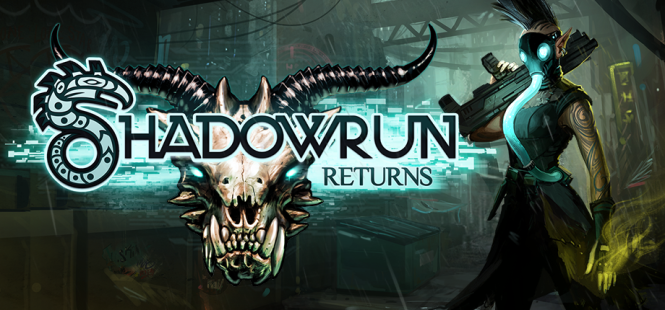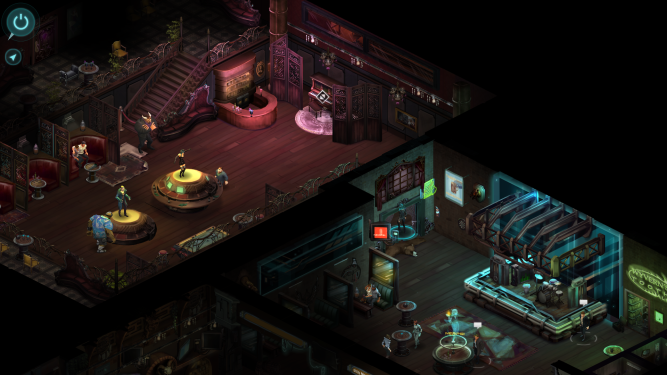
Shadowrun, as a setting and a world, has always fascinated me. A pulpy mixture of Tolkienesque high fantasy and the gritty noir flavor of Gibson’s cyberpunk, what else could an angsty adolescent male want? That is, besides a way to insert himself into that world without 50d6, vacant mouthbreathing stares, and that one decking player that always stalls the game for everyone else. (You know who you are…)

That’s right, Shadowrun is a tabletop RPG from back when the medium was in its prime. The first edition Shadowrun ruleset was released in 1989 and presented a world relentlessly steeped in the pop literature traditions of the time. Filled with quirky lingo like “chummer,” fantastical racial slurs like “dandelion eaters” (it’s for elves, if you were curious), and slang for new technological developments like “trid” (holographic 3D television), rereading the Shadowrun ruleset for the fifth time was a surefire way to impress your friends and immerse yourself in early 90’s cyberpunk.
At least it was if you were me… in middle school. I’ll confess, I exhausted every possible outlet for Shadowrun roleplaying that didn’t require social interaction. From the black ASCII screens of old school MUDs to the terrible first person shooter that made its way onto the scene in 2007, nothing filled the empty hole in my heart for Shadowrun. That’s why I, like so many others, was elated when the Kickstarter campaign was launched. A genuine Shadowrun CRPG complete with Steam Workshop support for a virtually limitless stream of content? Push that drek out, chummer! Shut up and take my credsticks!

In terms of gameplay, it’s a pretty standard turn-based RPG with a classless progression system taken straight from the tabletop game. It’s sleek, slim, and easy to understand so I won’t explain it here, but it’s not revolutionary, and it’s not exciting. Some design choices also slow and detract from the experience, like how clearing a combat area doesn’t always return you to the exploration movement mode, so your characters have to individually scramble. That’s not to mention the fact that this game, a mystery game about underworld espionage and infiltration, has no dedicated stealth system… so there’s that. The game’s systems are hardly ever turned on their heads, and when they are it’s often more frustrating and stalling than anything else. Despite a variety of character builds being available, most will feel the same to the player, because player agency is practically nonexistent in terms of narrative progression. That’s not to mention that some builds are far superior to others because of a design choice made in the last few hours of the game! Don’t play a shaman. Seems like a fun idea, isn’t really worth it. Diversify in a few different attributes, and have some fun with the combinations. That’s where the system shines.
As for the narrative, it’s stock. Full of archetypal characters with no deviation, even less motivation, and average character growth if any at all. If you thought Bioware was the king of bland, you haven’t met developer Harebrained Schemes yet. Of course, this is their first outing, but pushing more funding and development into the narrative would have helped this game more than anything else. There’s only one consistent companion, Coyote, in the game, and while they’re complete, they aren’t interesting. To make Shadowrun Returns’ short story shorter, your buddy Sam kicked the bucket but the campaign’s eponymous “Dead Man Switch” triggers with the message that he has money if you can get to the killer. In need of the cash, you go through a few twists and turns along the way, say hello to familiar faces in unfamiliar places, then realize that the most interesting parts of this story happen elsewhere – without you. I’d comment on the use of symbolism, metaphor, et cetera, but it’s either so on the nose you might as well be a Proboscis monkey, or just not there. As interesting as the setting could be, this is not a tale to sweep you away.

Shadowrun Returns falls especially flat in the narrative department because of its often excessive, flowery, and purposeless walls of text. I understand that not every game can be voice acted, especially one made on a Kickstarter budget, but it would have helped push things along and draw my attention in a more immersive way than what I got. The music is passable but only passable. You’ll find no sweeping beautiful arrangements in Shadowrun Returns, just dingy electrified beats in songs reused as much as the syllable “du” in Darude’s Sandstorm. As for the graphics, they’re vibrant and often varied, but stereotypical for the cyberpunk genre. Occasionally, a setpiece will attract my eye, but never for more than a few moments. Beyond that, the character models look like something straight out of 2006, and their animations, with every character hunching awkwardly as they shuffle to the designated spot, aren’t much better. Still, everything in Shadowrun Returns is perfectly functional.
FINAL VERDICT

Shadowrun Returns is a run-of-the-mill tactical turn-based CRPG with a lackluster whodunnit narrative and everything else to match. Its greatest strength is its intriguing setting and its greatest weakness is how little time it dedicates to exploring and giving life to that setting. $15 is a little steep if you only plan to play the Dead Man’s Switch campaign, but with comprehensive modding tools, there’s plenty more to explore. That being said, Shadowrun Returns was followed by two successors that most agree are far superior, so before you buy, consider picking up Shadowrun: Dragonfall or Shadowrun: Hong Kong instead.
